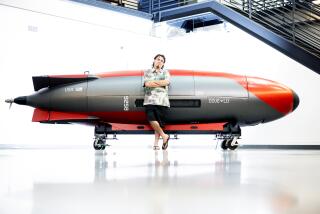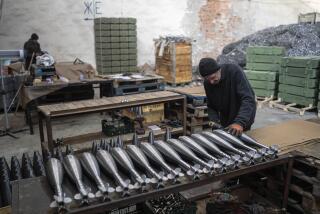In Oklahoma, Bombs Still Win Wars
- Share via
McALESTER, Okla. — McALESTER, Okla. -- As the Pentagon gears up for a potential war with Iraq, a little-known bomb factory on the rolling plains of southeastern Oklahoma has become the untouted epicenter of the military’s race to make the bombs, missiles and ammunition the U.S. military can’t go to war without.
At the McAlester Army Ammunition Plant, the sole provider of almost every conventional bomb dropped by the Army, Navy, Air Force and Marines, employees work 12-hour shifts and six-day weeks on orders to fill critical stockpiles. Employment on the production lines of the vast plant -- the largest employer in the region -- is up more than 10% in the last year, to more than 1,000.
Orders for bombs have more than doubled over two years ago.
“I like to say that we’re leaving McAlester’s calling card every time a U.S. plane drops a bomb,” said Army Col. Jyuji Hewitt, the plant’s commander.
The flurry of activity at McAlester is testament to a basic truth about the American military. While U.S. fighting has been portrayed in recent years as fueled by the technological advances in the way the military guides bombs and missiles, planes, ships and soldiers, the Pentagon’s ability to fight rests in large part on the vast industrial base built since World War II to make the elemental tools of war.
It is that infrastructure that rumbles into action when military action appears imminent.
“People think war-fighting today is about photons and electrons and snazzy computers,” said Gary Motsek, deputy director for support operations at the Army Materiel Command, which runs the plant. “But in fact, without places like McAlester, places that make the stuff that goes boom, they might as well not make the computers.”
By the standards of today’s gee-whiz war-fighting, where soldiers on the ground communicate instantly on hand-held computers with unmanned craft thousands of feet above them, there is nothing sexy about McAlester.
Its nearly 3,000 buildings of concrete and corrugated metal border on dilapidated. Its production lines are connected by rail track laid in 1943. And most of the work of making and filling bombs is still done by hand, by workers dressed in white coveralls and brimless canvas caps that make them look more like bakers than suppliers of a 21st century fighting force.
A sign greeting drivers entering McAlester’s city limits hails the town as “Home of cowboys and Italians” but makes no mention of the bomb factory that underpins its economy. Until this year, the plant was closed to the media.
McAlester has never been visited by a secretary of Defense or a president. Pentagon officials say the current Defense secretary, Donald H. Rumsfeld, is too busy to make the trip.
Yet the McAlester plant has a monopoly on a product the Pentagon cannot make war without. Because of the dirty and highly dangerous nature of bomb production, the military long ago decided to make most of its bombs in just one place.
McAlester’s bombs rained on Germany, Vietnam and Korea. Fitted with high-tech computerized guidance kits built by Boeing and others, McAlester’s bombs helped drive Slobodan Milosevic out of Bosnia, Saddam Hussein out of Kuwait and the Taliban out of Afghanistan.
And if the U.S. goes to war against Iraq, it will be explosives mixed in giant kettles and poured, fitted and sealed inside bomb casings at McAlester that will drop from America’s bombers, combat helicopters and fighter jets.
“I came out here to work in the first days before Desert Storm, and we were working 12 hours a day, six days a week. It’s starting to feel like that again,” said Pat Belcher, 70, who spoke as she fitted fuses onto artillery rounds. “I know as long as the situation is like it is, I’m going to be here, working overtime and weekends.”
Belcher said she lost a half brother in World War II. Like other workers at the plant, many of them the third or fourth generation of their family working at McAlester, she sought the job because it pays well for the area -- salaries start at about $11 an hour -- and has good benefits.
But she also says working at the plant gives her a certain amount of pride.
“I don’t want to go to war. I don’t want to see innocent people get killed,” she said. “But as long as I can remember, we’ve had to defend ourself against other countries. You’ve got to be strong. And what we make here is keeping us safe.”
Born in the rush to mobilize after Pearl Harbor and put up in six months, McAlester was once part of a giant network of military-owned ammunition plants and depots that stretched across the country. But from its earliest days, McAlester was unique.
Sprawling across 45,000 acres of prairie two hours from the nearest city, the plant is the military’s largest storage facility. It holds 6 million square feet of storage space on land three times the size of Manhattan. McAlester’s concrete igloos house stockpiles of ammunition for all four services -- from machine gun rounds to the 5,000-pound “bunker buster” bombs the Pentagon unleashed against Osama bin Laden.
The plant has not run at full capacity since the height of the Vietnam War, when it made 6,000 bombs every 24 hours. In the 1980s, it produced about that many in a year.
Defense officials are cagey about precisely how many bombs McAlester is producing these days. Army officials say it makes a profit -- mostly by renting out its space and facilities to private contractors such as Raytheon needing space to work with large quantities of explosive materials -- but won’t disclose its budget.
Under strict guidelines established in recent months, much of the production process is off-limits for viewing. But the officials acknowledge that those production lines are humming.
The popularity of the new generation of satellite-guided weapons has also given McAlester new life.
The plant produces “dumb bombs” -- metal casings of various sizes filled with explosives and fitted with a fuse and a detonator.
In one building on a recent day, workers poured plastic bonded explosive the consistency of clay into the 8-foot tall steel bomb casings that make up 2,000-pound bombs, then waited for the explosive to settle. In another building they topped the casings off, then capped them with metal plates and seamed them with a bonding agent. Workers painted the noses of the bombs bright yellow. Yellow is for the real bombs. Bombs without the paint have been filled with concrete and will be used for practice.
The work is dangerous. A fatal explosion at the plant in 1971 killed three workers. Last June, a man was crushed when a 2,000-pound bomb fell on him. Workers and visitors to the plant wear special shoes that reduce static electricity, which could set off a fire. Workers’ coveralls are laundered in flame retardant.
These bombs are imprecise. When dropped from planes, especially, they can land over a wide area. In World War II, bombardiers would sometimes entirely miss their targeted cities.
But today, these weapons have been transformed into “smart bombs,” guided by lasers, global positioning systems and sophisticated computer technology that can generally steer one to within 4 yards of its target.
The new bombs are essentially the same ones McAlester has been making for generations, but fitted with a GPS-controlled tail fin and strap-on winglets that help it glide. Known as joint direct attack munitions, the bombs emerged as the star of the Afghan war.
Of the 22,000 bombs dropped in that campaign, all were made at McAlester and then fitted with the smart “kits” produced by Boeing at a Missouri factory.
The bombs cost about $5,000 each when they leave McAlester. When military munitions crews fit the smart kits on them, their value goes up to $20,000 each.
The smart bombs became so popular in Afghanistan that their use taxed U.S. inventories. The Boeing factory was producing about 750 kits per month at the time of the Sept. 11 terrorist attacks, said Robert Algarotti, a Boeing spokesman.
Today about 2,000 kits a month are rolling off its production line, and by next August, Boeing hopes to be making almost 3,000 a month, Algarotti said.
“We’re not allowed to tell you how many we’re making at McAlester,” one Defense official said. “But I can tell you that every one of those smart kits has to go on something, and every one of the finished bombs is going to our war-fighters.”
More to Read
Sign up for Essential California
The most important California stories and recommendations in your inbox every morning.
You may occasionally receive promotional content from the Los Angeles Times.













